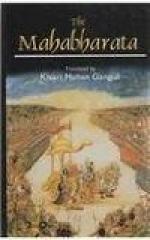39. i.e., that from which the entire universe has been created.
40. Probably, ‘by any of the senses’. The plural form occurs in the original.
41. This answers the questions respecting the form of the Soul, says Nilakantha.
42. I render this verse, following Nilakantha’s gloss. The second line of 50, according to that commentator, refers to the ascension of the Yogin from Brahma vested with attributes to Brahma divested of all attributes. The tam does not refer to body, as Telang takes it, but to Brahma as endued with hands and feet on all sides, etc. Deheswam dharayan means ‘restraining the mind within the body’. Kevalam Brahma is Brahma without attributes.
43. The speaker here is the regenerate visitor of Krishna. The latter is repeating the words of that visitor. In this verse, Krishna, forgetting that he is merely reciting the words of another, refers to himself as the Supreme Brahman in whom one must merge for attaining to Emancipation.
44. The second line of 56 is read variously.
45. Heaven is the reward of those who follow the religion of Pravritti or acts, such as sacrifices, religious observances, etc. The followers, however, of the religion of Nivritti or inaction, i.e., they who betake themselves to the path of knowledge, become emancipated. The deities derive their sustenance from the former and become even jealous of the latter, for the emancipate state is higher than that of the deities themselves.
46. Avichakshanam is undiscerning, in the sense of the husband’s not knowing that the interrogatrix as wife, has no other refuge than her lord with all his defects.
47. I follow Nilakantha. Telang adopts the views or Arjuna Misra and renders the first line as ’whatever acts are seized (by the touch, or seen, or heard, etc.’) Grahyam, according to Nilakantha, implies those acts, like Diksha, etc, which are adopted with the aid of others.
48. This seat, says Nilakantha, is called Avimukta and lies between the eyebrows and the nose.
49. Nilakantha interprets this mystically. By Soma he understands the artery or duct called Ida, and by Agni the duct called Pingala. Dhira is Buddipreraka; vyavayam is sancharam. Dhirobhutani dharayan nityam vyavayam kurute is the order of the words. The sense is this: in this spot is seated Brahman; there Ida and Pingala meet; and there also is Vayu which urges the understanding and upholds all living creatures.




